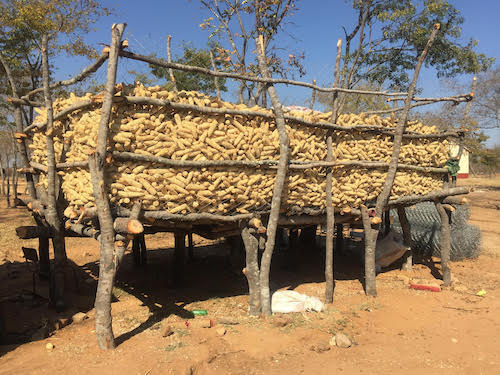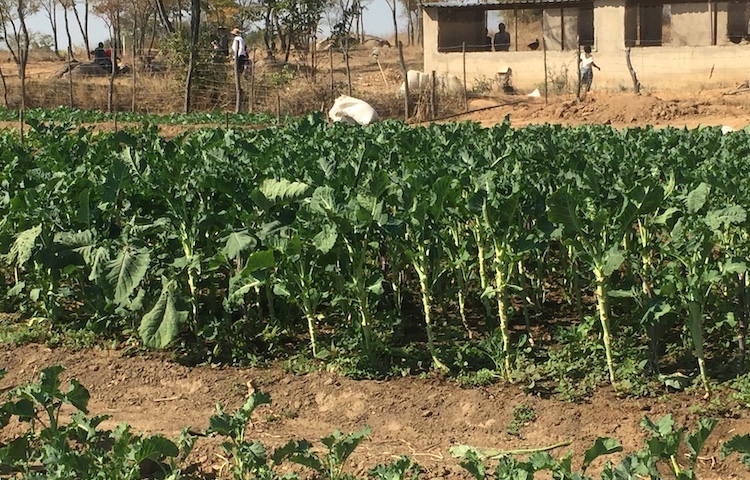By Jeffrey Moyo
HARARE, Zimbabwe (IDN) — At unoccupied swathes of land behind houses in Bloomingdale, a medium-income suburb in the Zimbabwean capital Harare, numerous maize fields and vegetable gardens have emerged as urban dwellers enduring economic hardships switch to backyard farming.
Zambia, despite emerging from an economic crisis during former President Edgar Lungu’s reign that ended last year, has dozens of urban dwellers taking up agriculture to supplement their earnings. JAPANESE | SWAHILI
The same goes for Mozambicans east of Zimbabwe, who have scrambled for every vacant piece of land across towns and cities in the coastal nation.
Not to be outdone, Malawi, located north of Zimbabwe, has urban agriculture becoming a way of life.
In fact, as many Southern Africans contend with inflation and food deficits, hordes of urban dwellers across the region are fast switching to farming in their backyards.
All across the region, the media has been awash with reports of industries shutting down over the past decades, leaving many rural migrants to the cities and towns stranded.
For some, the option has been to shift to backyard farming in their city homes.
As that happens, in Harare, urban farmers like 63-year-old Livias Gono of Mufakose’s high-density suburb now send bags of maize harvested from his backyard fields to his relatives stung by hunger in his village in Mberengwa.
Mberengwa is a Zimbabwean rural district in the country’s Midlands Province.
Almost yearly, Mberengwa villagers, who included Gono’s relatives, have been stung by starvation amid growing climate change impacts.
“I spend most of my maize yields to my relatives in my village in Mberengwa because they always have droughts,” Gono told IDN.
With 90 per cent unemployment in Zimbabwe, hunger has not spared the urban dwellers either, forcing many of them to venture into farming in their backyards.
Last year, hunger in Zimbabwe’s urban areas left 2.4 million people struggling to meet their basic food needs, according to the Zimbabwe Vulnerability Assessment Committee (ZimVAC) report.
ZimVAC is a technical advisory committee comprised of representatives from the government, development partners, UN and non-governmental organizations.
Annual inflation at 269 per cent has also clobbered Zimbabwe’s urban dwellers.
In Zambia, even as inflation was curtailed at the coming of President Hakainde Hichilema to power last year, urban residents still have to carry on with backyard farming.
Such are many, like 47-year-old Laura Phiri, a widow with five children who live at the heart of the capital Lusaka, where she has made it a point to grow vegetables to supplement the family’s diet.
“I’m jobless, and if I don’t do this, my children will starve,” Phiri told IDN.
Growing vegetables in her backyard have also enabled Phiri to earn some income which she has used to pay monthly bills.
“I earn about 3,000 Zambian Kwacha (approximately 180 U.S. dollars) monthly from selling vegetables, meaning this has given me a new lease of life,” Phiri said.
In their backyards, a lot more other unemployed Zambians like 53-year-old Kennias Banda in Kitwe, Zambia’s third largest city, have switched to livestock production in order to earn income.
He (Banda) said he rears chickens for sale—400 of the birds at his Kitwe home.
Zambia has 13 per cent unemployment.
But the African nation has also had its urban dwellers grappling with starvation.
As a result, the World Food Programme has been on record in Zambia, providing the poorest families in low-income urban areas with 400 Zambian Kwacha, about US$ 22 a month, enough to meet half their daily food requirements.
With a population of about 19 million people, poverty has become a characteristic feature of urban living in Zambia, with statistics showing that of the 4.3 million people domiciled in Zambia’s towns and cities, 34 per cent live in extreme poverty while 18 per cent are moderately poor.
Daniel Chanda, a Zambian development expert, said, “urban agriculture has helped enlarge the economic outlook of towns and cities through growing of edible crops in backyards”.
With urban backyard farming on the rise in Zambia, he (Chanda) also said this has increased entrepreneurial activities across towns and cities in the southern African nation.
In Malawi, urban agriculture has also stolen the show, attracting many, like 45-year-old Lucia Bandawe in Lilongwe, the country’s capital.
“When I was growing up, there were no urban vegetable gardens, but now all that has changed as people farm at the back of their houses,” she (Lucia) told IDN.
Yet of late, according to Bandawe, urban agriculture in Malawi was further necessitated by restrictions on movement introduced in the wake of Covid-19 two years ago.

< Photo: 63-year-old Livias Gono of Mufakose high-density suburb in the Zimbabwean capital’s harvested maize stored in a makeshift barn near his urban home. Credit: Jeffrey Moyo/ IDN.
Then, faced with food deficits as urban Malawians stayed indoors, Bandawe said many of them were forced to turn to agriculture.
Now, even with coronavirus restrictions almost gone, backyard farming in towns and cities has had to remain, becoming part of life for urban Malawians.
63-year-old Kumbukani Bvumbwe, a fisherman in Malawi’s Blantyre, is one such urban farmer.
“I personally think if given the backing, urban agriculture can become a way of defeating poverty in towns here in Malawi because many people don’t have jobs,” Bvumbwe told IDN.
He (Bvumbwe) said this even as many Malawian civil society activists like Jimson Bwanali remain sceptical about the whole idea.
“Policymakers must dig out for more accurate information on how urban farming really contributes to fending off food deficits and poverty here. It’s difficult to tell when just a few people are doing this,” Bwanali told IDN.
In Mozambique’s Infulene Valley, which is the country’s key green belt, the growing of vegetables there is massive, with farmers taking advantage of the Milauze river dividing the cities of Maputo and Matola and the Costa do Sol, with urban agriculture there practised by several people.
Statistics from the Mozambican government, in fact, show that in Maputo and the surrounding area, over 10,000 small-scale farmers practice agriculture within the city- the country’s capital.
Ranked 181 of 189 countries in the 2020 Human Development Index and located in south-eastern Africa, Mozambique is a low-income, food-deficit country with a largely rural population of 28 million.
Meanwhile, in Namibia, the country’s agriculture ministry has gone on record in the media, launching a special project on urban agriculture aimed at strengthening the country’s food self-self-sufficiency.
This is happening at a time the UN has estimated that 66 per cent of the world’s population will be living in cities by 2050, meaning backyard farming may become the sole answer to food needs in future.
In Botswana, faced with slow economic growth amid rapid urbanization, some people have already been forced to turn to urban subsistence farming as well as commercial urban and peri-urban agriculture.
In South Africa’s Cape Town, small urban farms in Phillippi (an area that covers roughly 34 sq. km)—are being leased out to people growing food, earning income as a result.
A common practice now, urban agriculture in Eswatini (former Swaziland) remains an illegal activity that is not supported by municipal laws despite its known capacity to fend off food deficits.
In Lesotho, amid rural-to-urban migration, agriculture has increasingly been seen as the panacea to urban food insecurity.
In fact, Lesotho has regularly featured in the African and international media as a country devastated by drought, hunger and food insecurity. [IDN-InDepthNews – 30 November 2022]
Photo: Some urban Zimbabweans have resorted to growing vegetables in their backyards to supplement their food amidst rising inflation in the country. Credit: Jeffrey Moyo/ IDN.




